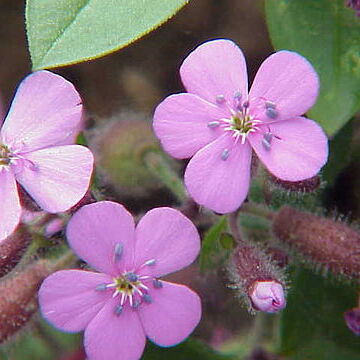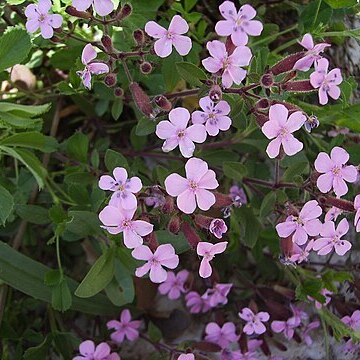Herbs, annual or perennial, erect, glabrous or hairy. Leaves opposite, narrowly spathulate to linear-oblanceolate or oblong-ovate; bracts herbaceous; stipules absent. Flowers in paniculate to capitate, dichasial cymes, 5-merous, bisexual. Epicalyx absent. Calyx tubular, cylindrical, 15–25-veined, not scarious between veins, herbaceous, 5-lobed. Petals 5, white, yellow, pink or purple, exceeding calyx; coronal scales present. Stamens 10. Ovary 1-celled; styles 2 (3). Capsule cylindrical to ovoid, opening by 4 (6), teeth; carpophore short. Seeds few to many, reniform, ±compressed, bluntly tuberculate, with a lateral hilum.
Annual to perennial herbs. Hairs glandular and/or eglandular or 0. Lvs opposite, exstipulate, ovate to linear to spathulate. Infl. a lax to capitate dichasium, sometimes a panicle; bracts leaflike; epicalyx 0. Calyx cylindric or oblong, 5-veined, 5-toothed, with green commissures between the veins. Petals 5, white or pink, clawed or narrowed to base, entire to 2-fid; coronal scales usually present. Stamens 10. Styles 2. Fr. a cylindric to ovoid capsule dehiscing by 4 teeth; carpophore short. Seeds reniform, compressed, not winged.
Herbs annual or perennial. Stem solitary, erect. Leaves lanceolate, elliptic or spatulate, 3-or 5-veined. Inflorescence a cyme, panicle, or capitulum. Calyx cylindric, 15-to 25-veined, not membranous between veins, 5-toothed. Petals 5, red or white, margin entire, emarginate, or 2-lobed; claw long, narrow; coronal scales usually present. Stamens 10. Ovary 1-loculed; styles 2. Androgynophore short. Capsule cylindric or ovoid, crustaceous, dehiscing with 4 teeth. Seeds reniform, tuberculate or striate; embryo annular.
Annual, biennial, or mostly perennial herbs, glabrous or hairy. Leaves of varying shape, sessile or petiolate. Inflorescences cymose, capitate or paniculate. Calyx cylindrical, many-nerved. Bracts herbaceous, bracteoles absent. Calyx cylindrical, 5-dentate. Petals with winged claw, lamina with or without coronal scales. Stamens 10. Ovary with many (rarely few) ovules. Styles 2 (or 3). Capsule dehiscing by 4(-6) short valves or teeth. Seeds reniform, flat, tuberculate.
Infl ± congested or of open cymes; cal cylindric, membranous, 20-nerved; pet with distinct claw and blade, the appendages conspicuous, subulate; stamens 10; styles 2(3); capsule dehiscent by 4(–6) teeth; seeds rotund-reniform, uniformly reticulate; perennial herbs. 30, temp. Eurasia.


